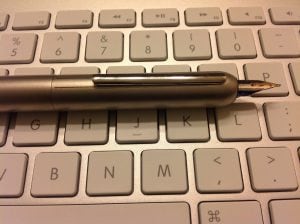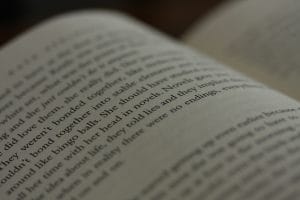In a 2015 report, the Foundation for Young Australians highlighted the importance of enterprise skills, including digital literacy and critical thinking, for navigating a range of complex careers. These skills are seen as essential for enabling tomorrow’s job seekers to be competitive in the job market and to earn higher wages. The report confirms that between 2012 and 2015 the demand for digital literacy skills increased by 212 % while the demand for critical thinking skills increased by 158 %, which makes both of these key qualities for graduates seeking employment.
Since our graduates will be working in increasingly agile and digitally-focused environments, we need to think about how we can help them develop these enterprise skills, including digital writing skills, as part of their degrees, which is why myself and five colleagues from the English department (Beth Yahp, Brigid Rooney, Fiona Lee, Kate Lilley, and Rebecca Johinke) decided to trial how to integrate digital writing (including online response posts, podcasts, and videos) into the English curriculum. One of our key aims was to help our students to become critically aware, confident, and responsible digital citizens who are versed in working effectively across different media in both real-world and digital spaces. Supported by a Strategic Education Innovation Grant from the DVC Education, we tried different approaches to using these tools both in our class activities and in our assessments.
Active Learning Using Digital Research Resources and Tools in the Classroom
(text by Rebecca Johinke)
In the discipline of contemporary magazine studies, it is essential that students are able to analyse the digital profile and presence of magazines but they often don’t know how to use online resources to gain a comprehensive understanding of a magazine’s reach, popularity, and digital marketing strategy. Students taking Rebecca Johinke’s ENGL6970 Reading Magazines constantly needed to move back and forth from print to digital, and to be able to access traditional scholarly research materials like books and journal articles but they also needed to check sales figures, media kits, industry websites, social media, and a range of other digital resources (including TROVE and Austlit Database).
In every class, students worked in small groups answering a range of discussion questions and they chose four to write up into low-stake 500-word discussion points for assessment (5% each) in preparation for two larger assignments worth 40% each. Students had a choice of completing
- a PowerPoint ‘conference’ audio presentation, where students answered a self-devised research question about magazines in the form of a recorded presentation that had to be loaded directly online rather than presented in class;

Wikipedia logo (c) M MG https://bit.ly/2KkvUmi - a Wikipedia entry, which required students to learn how to edit and create an entry and how to create hyperlinks, insert references, and source images; or
- a job application to a target magazine, which required students first to undertake a close reading of a particular magazine title and a rhetorical analysis of the magazine and its readers and then to position themselves in relation to the magazine’s audience.
All three assignment types required students to be more creative and digitally and visually literate when composing their work. In every case, students needed to learn new skills in presentation and digital and audio.
Students responded positively to the choice of assessment formats, for example one student noted in the USS feedback: ‘I thought the free choice of final assessments was refreshing. The use of a Wikipedia entry as an assessment was also very original and challenging to undertake.’ Another person noted that the best part of the class was: ‘The flexibility and original nature of the assessment tasks.’ Some students had problems loading large files to Canvas via Turnitin but the Educational Designers are already working with staff to improve this interface for the next iteration of the unit.
A Virtual Discussion and Workshop Space to Augment Classroom Learning
(text by Beth Yahp)
In ENGL2666: Creative Writing: Theory and Practice, Beth Yahp introduced the use of a workshop blog/discussion space where students engaged in several formative assessment tasks. In the reader response task, students wrote and posted short critical responses to set readings, which were discussed in class and/or commented upon by other students on the blog. In the creative writing draft task, students posted their creative drafts to the blog, which were read by everyone and workshopped in class. Students then had the opportunity to refine their ideas, approaches and writing to be submitted as part of their final research essay and creative writing portfolio assignments. As these tasks were designed to align with graduate qualities A, B, C, and E, the emphasis was equally upon learning and practicing discipline-specific knowledge, skills and techniques, and actively working together to create a rigorous but supportive workshop space. This space required a form of teamwork which enabled capacity-building in terms of cultural competence, integrity, and personal resilience by allowing students to learn by modeling and practicing how to give and receive responsible critiques of creative writing that is often personal or tackled challenging real world issues.

Over 75 % of the students agreed that the reader response task developed their critical and analytical skills and indicated that they felt encouraged to interact responsibly on the blog. They also reported that they received useful feedback/comments as well as being encouraged to redraft their work or write more based on those comments. Students also reported that having an audience of peers for their writing and thoughts affected their writing, commenting for example that ‘having other people read my writing, it had to be more professional’. Students also felt that the blog space ‘gave the sense of progression: that we, as a class, were accumulating knowledge’ and ‘it felt like a safe space and a good push to show your writing’. This was also confirmed by the tutors who indicated that the digital space improved and encouraged discussion in the classroom, although it did require extra preparation time.
Since first trialing the use of the workshop blog/discussion space for this project, Beth has refined the digital writing assessments based on feedback from students and tutors. For example, in the new first-year unit ENGL1014 Creative Writing that Beth is coordinating and teaching in S1, 2018, students are required to make fewer posts for their reader response task; these posts receive feedback from tutors but are not graded. Students then refine and submit their redrafted reader response posts based on tutor feedback and class discussion as part of their final assignments. This addressed the issue of previous students reporting that they felt inhibited from posting or fully participating in the digital space because of anxiety about being graded and receiving negative feedback from tutors and peers. Tutors can now also focus on discussion and giving useful feedback to students in the digital and classroom environment and leave grading for the final assignments. The utilization of the more user-friendly Canvas platform in S1, 2018 has also increased student participation in the digital space and has eliminated many of the technical difficulties related to posting, commenting, and even finding posts.
Online Posts to Enhance Resilient Reading and Peer-to-Peer Learning
(text by Brigid Rooney)

One of the challenges today’s students face in the contemporary screen-dominated and information rich environment is finding both the time and focus to read long and at times challenging literary novels, let alone to pace themselves in managing a big reading load across a full semester. This is a well-known issue that resonates across many disciplinary contexts. To address this need, Brigid Rooney successfully incorporated into several units (at undergraduate and postgraduate levels) the requirement that students present short initial impressions to the set text as preparation for the relevant tutorial or seminar via a series of online posts. Brigid adapted this idea from The Reading Resilience Toolkit. Making the task of reading assessable aligns with Brigid’s unit outcome of students’ developing resilience as readers of experimental texts.
While this has worked well, Brigid saw an opportunity to use this task to foster peer-to-peer dialogue across virtual and face-to-face classrooms, and try to build a more vital and engaged learning community in the classroom. As part of the Strategic Education Innovation project, Brigid refocused the task for her postgraduate and honours seminar unit, ENGL6115 Reading Suburbia. Two students each week were given the job of reflecting on their peers’ online posts and leading discussion for a part of the seminar based on this material. Although the logistics of organising this and maintaining it each week were at times cumbersome, the two-hour seminar space was capacious enough and the overall result was encouraging. In seminars, the students gradually became familiarised and more practised in engaging in direct peer-to-peer conversation around the texts, and this deepened and enriched the dialogue. Students would often refer back to points others had made in online posts as well as elaborating on their own initial ideas. Student feedback corroborated these impressions. In the future, Brigid will be looking at ways to streamline and simplify this structure, perhaps by building on student self-evaluation about how they themselves have connected the online posts with classroom community.
Video Close Reading Assignments to Engage with Critical Theory

Another thing that our students often struggle with in English literary studies is applying critical theory to literary texts. This was one of the reasons, Isabelle Hesse used video close readings in ENGL1013 Global Literatures in English, a new first-year unit she coordinated and taught in S2, 2017. For this task, students were asked in pairs to make a video about the key points from a critical reading and apply these to a literary/cinematic text. The aim was to encourage in-depth engagement with texts and their contexts but also to draw on research that emphasises the power of videos in engaging and motivating students and the potential for students to learn a concept more easily.
The students reacted quite positively to this assignment. Although there were those who would have preferred to complete a more traditional assessment, 68.6% of the students agreed or strongly agreed with the statement that ‘The video close reading task helped me apply critical theory to literary and cinematic texts.’ When asked which other skills they developed as part of this task, 45% of the responses mentioned inventiveness, team-work, and communication skills, all of which are part of the new qualities that our graduates should develop, as outlined in Strategy 4 of the University’s Strategic Plan, 2016-2020.
There were a few technical issues, including not being able to use the comment function in the Arc Media Gallery on Canvas when sharing the videos with individual tutorial groups, which meant that some of the interactivity that this assignment was supposed to create was lost. However, next time Isabelle uses this type of assignment, she will show the videos in class, as this both circumvents the issue with the comment function in Arc and encourages more in-depth student engagement with and discussion of the videos.
Conclusion
In spite of some teething problems, which were partly due to using Blackboard, the project team found that the digital writing tasks enhanced not only the development of core disciplinary skills, such as reading, critical thinking, and academic and creative writing, but also gave students the opportunity to apply these skills in a digital context as well as developing new skills. Some of the benefits of using digital writing tasks included creating an inclusive and participatory space, enhancing student engagement with texts and contexts and with their peers, and it also often resulted in clearer and more effective communication. While it takes a bit more time to set up and explain these types of tasks and assignments, and to solve technical issues, we think that they are certainly worthwhile as an alternative or a complement to ‘traditional’ assignments, especially in terms of moving the English classroom into the twenty-first century.
Further information about the different tasks we used can be found on our Open Canvas Site, which will be updated throughout the year. You can also import some of our Canvas pages with detailed assignment instructions through the University of Sydney collection on Canvas Commons.





